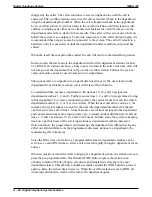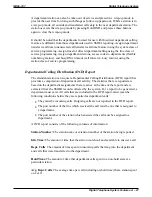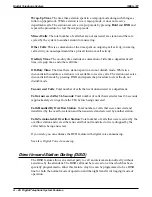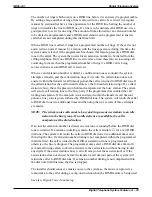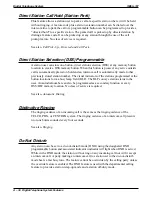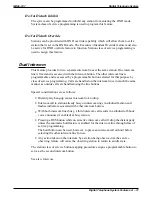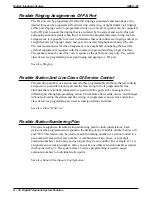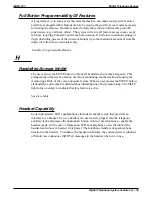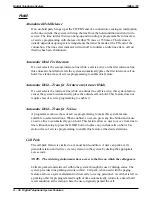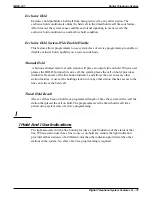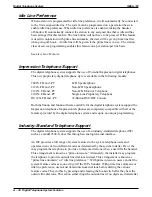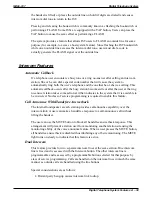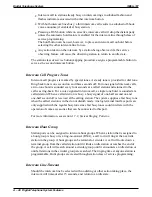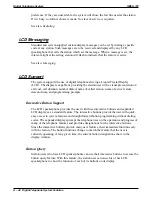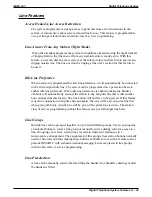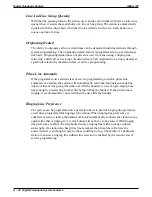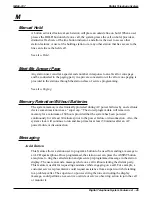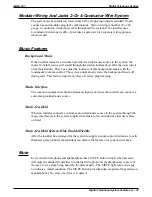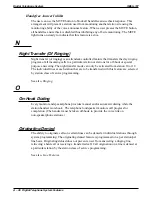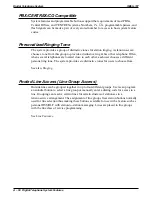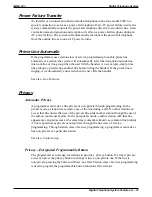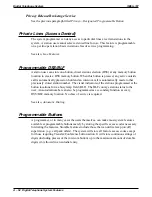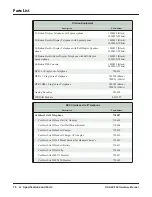
•
Intercom call to station already busy on intercom rings in subdued fashion and
flashes indicator associated with other intercom button.
•
With both intercom lines busy, a third intercom call results in a subdued off-hook
voice announce (if enabled) at busy station.
•
Pressing a DSS button while on an active intercom call will drop the distant party
unless the automatic hold feature is enabled for the intercom line through class of
service programming.
The hold button can be used, however, to place an intercom call on hold before
selecting the other intercom line for use.
•
Any action taken on the intercom by a station being observed via the service
observing feature will cause the observing station to return to an idle state.
The station class of service button mapping procedure assigns a programmable button to
serve as the second intercom button.
Intercom Call Progress Tones
Intercom call progress is marked by special tones. A steady tone is provided for dial tone.
Ring-back tone is one second on and three seconds off. For tone-signaled intercom calls,
a two-tone burst is sounded every four seconds at a called station and returned to the
caller as ring-back. For a voice signaled intercom call, a single tone burst is sounded at a
called station. When a called station is busy, a busy signal of one-half second on and
one-half second off is received at the calling station. The system supplies a fast busy tone
when the called station is in the do not disturb mode. Analog terminal interface ports are
only supplied with the regular busy tone since fast busy tones could interfere with the
operation of some accessories that can be connected to this port.
For more information, see section 1.7.2, System Ringing Patterns.
Intercom Hunt Group
Station ports can be assigned to intercom hunt groups. When a station that is assigned to
a hunt group is busy or is a ring-no-answer (RNA), a call to it will ring at the next idle
station in the group. A hunt group can be terminal or circular. A call will route down a
terminal group from the called station until it finds an idle station or reaches the end of
the group. A call will search around a circular group until it encounters an idle station or
until all stations in the circular group are searched. The ringing time at anyone station is
programmable. Hunt groups are created through station class of service programming.
Intercom Line Timeout
Should the intercom line be selected with no dialing or other action taking place, the
intercom will timeout after 15 seconds, and return to an idle state.
Digital Telephone System
IMI66–107
A – 40 Digital Telephone System Features
Summary of Contents for Air Impact DSU
Page 2: ...Printed in U S A GCA47 157 ...
Page 30: ......
Page 112: ......
Page 192: ...Digital Telephone System IMI66 107 3 80 System Programming ...
Page 283: ......
Page 284: ......
Page 285: ......
Page 286: ......
Page 287: ......
Page 288: ......
Page 289: ......
Page 290: ......
Page 291: ......
Page 292: ......
Page 293: ......
Page 294: ......
Page 295: ......
Page 296: ......
Page 297: ......
Page 298: ......
Page 299: ......
Page 300: ......
Page 301: ......
Page 302: ......
Page 303: ......
Page 304: ......
Page 305: ......
Page 306: ......
Page 307: ......
Page 308: ......
Page 309: ......
Page 310: ......
Page 311: ......
Page 312: ......
Page 313: ......
Page 314: ......
Page 315: ......
Page 316: ......
Page 317: ......
Page 318: ......
Page 319: ......
Page 320: ......
Page 321: ......
Page 322: ......
Page 323: ......
Page 324: ......
Page 325: ......
Page 326: ......
Page 327: ......
Page 328: ......
Page 329: ......
Page 330: ......
Page 331: ......
Page 332: ......
Page 333: ......
Page 334: ......
Page 335: ......
Page 336: ......
Page 337: ......
Page 338: ......
Page 339: ......
Page 340: ......
Page 431: ......
Page 436: ......
Page 437: ......
Page 438: ......

